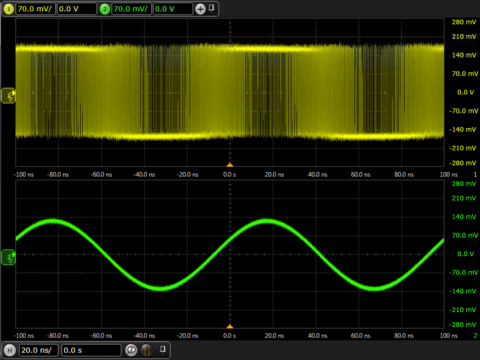Summary
Practically all measurable physical phenomena are eventually transformed into corresponding electrical representations. The transduction of a signal into its electrical counterpart and its subsequent conversion into the digital domain are steps that often include a loss of fidelity. Our goal is to mitigate such effects by developing measurement science innovations in electrical waveform metrology. We accomplish this objective by harnessing the remarkable stability and accuracy of quantum electrical standards, such as the Programmable Josephson Voltage Standard (PJVS) and the Josephson Arbitrary Waveform Synthesizer (JAWS). Our efforts impact existing electrical metrology applications, as well as nascent programs in data converter fidelity, distorted power, and quantum devices and materials.
Description

Delta--sigma modulation behind the Josephson Arbitrary Waveform Synthesizer (JAWS)
The 2019 redefinition of the SI was motivated in part by the success of quantum electrical standards, such as those based on the Josephson and quantum Hall effects. Quantum standards enable the direct realization of physical quantities that are traceable to fundamental constants, invariant with respect to time, and in some cases, readily disseminated. In addition to speeding the metrological shift away from artifacts, quantum standards may usher in new measurement capabilities or profoundly reduce measurement uncertainties.
Fundamental JAWS Metrology
A major priority of our project is the dissemination of the ac quantum volt via the JAWS. The JAWS can synthesize audio waveforms with residual distortion as low as parts in 109, as well as amplitude and phase uncertainties below a part in 106. By digitally controlling the timing and density of input current pulses, arbitrary waveform generation is possible. The quantum accuracy of the JAWS is diminished as the measurement plane moves further from the cryogenic environment of the Josephson junction arrays. Although such limitations arise from purely classical effects, they must be rigorously evaluated to minimize uncertainties. To improve practical uncertainties, we are developing custom instrumentation and techniques to either mitigate such systematic errors or to accurately quantify them. There are presently three JAWS systems in use within the Applied Electrical Metrology Group: two based on immersion into liquid helium (rms voltages up to 1 V) and one cryocooled system (two channels at 1 V each). We are in the process of building additional immersion probes and another cryocooled JAWS.
Dissemination of the DC volt
We support absolute and ratio dc voltage dissemination through a combination of Josephson voltage standards and calibrated Zener voltage standards. These efforts enable SI traceability for internal and external customer voltage standards and digital multimeters. Efforts are underway to modernize this program to calibrate customer devices directly against the latest quantum voltage standards.
Research and Development
We are actively engaged in leveraging quantum-based electrical standards to enable new measurement applications. Some of our research activities include low-temperature electronic thermometry; systems integration of multiple quantum standards; high-resolution data converter calibration; and harmonic power metrology in support of the Smart Grid.
Major Accomplishments
- First-ever integration of a programmable Josephson voltage standard and a quantum anomalous Hall resistance standard to create an instrument capable of realizing all three electrical units: the SI volt, ohm, and ampere. This effort was awarded the U.S. Department of Commerce’s Gold Medal in 2025 (along with other Quantum Measurement Division staff).
- JAWS-to-JAWS ac-dc intercomparison
- JAWS-referenced sinusoidal ac power from 40 Hz to 6 kHz
- JAWS load compensation beyond 100 kHz with a negative impedance converter
- Rigorous uncertainty analysis for Army Primary Standards Laboratory

